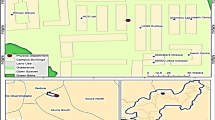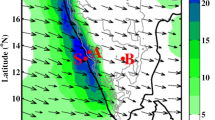Abstract
Raindrop sizes were obtained from Butare, Rwanda (2.6°S, 29.74°E) and Durban, South Africa (29°52′S, 30°58′E) using the Joss–Waldvogel RD-80 disdrometer. The obtained data is used for the analysis of the drop size distribution (DSD) and specific rainfall attenuation modeling in these African countries identified as equatorial (Butare) and subtropical (Durban) regions. The influence of the raindrop diameters that are critical to the DSD and specific rain attenuation at operating frequencies of 10–150 GHz is investigated using the estimated R 0.01 values for Butare and Durban. Parameter fittings for the proposed DSD models at these locations for different rain rate values are investigated. The proposed drop size distribution models are also compared with those of other countries. At operating frequency range 10 ≤ f ≤ 40 GHz, the specific attenuation in Rwanda tends to be higher when compared to Durban. However, at frequency above 40 GHz, Durban shows a higher specific attenuation than Rwanda. The largest contributions to the overall specific rain attenuation are formed by drop diameters in the range 1.5 ≤ D ≤ 3.5 and 1.0 ≤ D ≤ 3.0 mm for Rwanda and South Africa, respectively, especially at higher frequencies. A minimal contribution is observed at the larger diameters. The influence of the disdrometer bins on the attenuation due to rain is also analyzed for these locations. The estimation will be useful to properly design adequate fade margin levels and for the purpose of link budget design by service providers and system engineers in the regions.








Similar content being viewed by others
References
Marcus M, Pattan B (2005) Millimeter wave propagation: spectrum management and implications. IEEE Microw Mag 6(2):54–62
Crane RK (1996) Electromagnetic wave propagation through rain, 1st edn. Wiley, New York, University of Oklahoma
Ojo JS, Ajewole MO, Sarkar SK (2008) Rain rate and rain attenuation prediction for satellite communication in Ku and Ka bands over Nigeria. Prog Electromagn Res 5:207–223
Chen HY, Lin DP (1999) Volume integral equation solution of microwave absorption and scattering by raindrops. IEEE Xplore 4:2676–2679
Garcia-Rubia JM, Riera JM, Garcia-del-Pino P, Benarroch A (2011) Propagation in the Ka band: experimental characterization for satellite applications. IEEE Antennas Propag Mag 53(2):65–76
Kesavan U, Tharek AR, Sharul KAR, Rafiqul MI (2013) Review of rain attenuation studies in tropical and equatorial regions in Malaysia: an overview. IEEE Antennas Propag 55(1):103–113
Ajayi GO, Olsen RL (1985) Modeling of a raindrop size distribution for microwave and millimeter wave applications. Radio Sci 20(2):193–202
Adimula IA, Ajayi GO (1996) Variation in raindrop size distribution and specific attenuation due to rain in Nigeria. Ann Telecommun 51(1–2):87–93
Lee YH, Lakshmi S, Ong JT (2007) Raindrop size distribution modeling in Singapore-critical diameters. The Second European Conference on Antenna and Propagation (EUCAP), 11–16 November 2007, Edinburgh, UK
Timothy KI, Ong JT, Choo EBL (2002) Rain drop size distribution using method of moments for terrestrial and satellite communication applications in Singapore. IEEE Trans Antennas Prop 50(10):1420–1424
Kumar SL, Lee YH, Ong JT (2010) Truncated gamma drop size distribution models for rain attenuation in Singapore. IEEE Trans Antennas Prop 58(4):1325–1335
Afullo JO (2011) Raindrop size distribution modeling for radio link along the eastern coast of South Africa. Prog Electromagn Res 34:345–366
Alonge AA, Afullo TJ (2012) Regime analysis of rainfall drop-size distribution models for microwave terrestrial networks. Inst Eng Technol Micro Antennas Prop 6(4):393–403
Mätzler C (2002) Drop-size distributions and Mie computation. IAP Research Report 2002–16, University of Bern, Bern, November
Ajayi GO (1990) Some aspects of tropical rainfall and their effects on microwave propagation. Int J Satell Commun 8(3):163–172
https://www.princeton.edu/achaney/tmve/wiki100k/docs/Geography_of_Rwanda.html. June 2013
http://www.nationsencyclopedia.com/Africa/Rwanda-CLIMATE.html. June 2013
Fashuyi MO, Owolawi PA, Afullo TO (2006) Rain rate modeling for LOS radio systems in South Africa. Trans. of South African Inst. of Elect. Engineers (SAIEE), 2006, 97, pp. 74–81
Odedina MO, Afullo TJ (2008) Characteristics of seasonal attenuation and fading for line-of-sight links in South Africa. Proceedings of Southern Africa Telecommunications Networks Applications Conference (SATNAC), 2008, pp. 203–208
Odedina MO, Afullo TJ (2010) Determination of rain attenuation from electromagnetic scattering by spherical raindrops: theory and experiment. Radio Sci. doi:10.1029/2009RS00419
Owolawi PA (2010) Characteristics of rain at microwave and millimetric bands for terrestrial and satellite links attenuation in South Africa and surrounding islands. Ph.D. Thesis, University of KwaZulu Natal, South Africa, July 2010
Alonge AA, Afullo TJ (2012) Seasonal analysis and prediction of rainfall effects in eastern South Africa at microwave frequencies. Prog Electromagn Res 40:279–303
Adetan O, Afullo TJ (2012) Three-parameter raindrop size distribution modeling for microwave propagation in South Africa. Proceedings of the International Association of Science and Technology for Development (IASTED), International Conference on Modeling and Simulation, September 2012, Gaborone, Botswana, pp. 155-160. doi:10.2316/P.2012.761-027
Adetan O, Afullo TJ (2012) Comparison of two methods to evaluate the lognormal raindrop size distribution model in Durban. Proceedings of Southern Africa Telecommunications Networks Applications Conference (SATNAC), 2012, Fancourt, George, South Africa, ISBN 978-0-620-53713-1
Akuon PO, Afullo TJ (2011) Rain cell sizing for the design of high capacity radio link system in South Africa. Prog Electromagn Res 35:263–285
Adetan O, Afullo TJ (2013) The critical diameters for rainfall attenuation in southern Africa. Prog Electromagn Res 46:275–297
Joss J, Thams JC, Waldvogel A (1968) The variation of raindrop-size distribution at Locarno. Proceedings of International Conference on Cloud Physics, 1968, pp. 369–373
Baltas E, Mimikou M (2002) The use of Joss-type disdrometer for the derivation of ZR relationships. In Proc. ERAD, 2002, pp. 291–294
Townsend AJ (2011) A study of raindrop size distributions and its effects on microwave. PhD thesis, University of Bath
Sheppard B, Joe P (1994) Comparison of raindrop size distribution measurements by a Joss-Waldvogel disdrometer, a PMS 2DG spectrometer and a POSS Doppler radar. J Atmos Ocean Technol 11:874–887
Gunn R, Kinzer GD (1949) Terminal velocity of fall for water drops in stagnant air. J Appl Meteorol 6:243–248
Caraciolo C, Prodi F, Battaglia A, Porcu F (2006) Analysis of the moments and parameters of gamma DSD to infer precipitation properties: a convective stratiform discrimination algorithm. Atmos Res 80:165–18
Tokay A, Short DA (1996) Evidence from tropical raindrop spectra of the origin of rain from stratiform to convective clouds. J Appl Meteorol 35(3):355–371
Ulbrich CW (1983) Natural variations in the analytical forms of the raindrop size distribution. J Clim Appl Meteorol 22:1764–1775
Mathews PA (1965) Radio wave propagation VHF and above. Chapman and Hall, London
Ajayi GO, Feng S, Radicella SM, Reddy B (eds) (1996) Handbook on radio propagation related to satellite communications in tropical and subtropical countries. ICTP, Trieste, pp 7–14
Deirmendjian D, Clasen R, Viezee W (1961) Mie scattering with complex index of refraction. JOSA 51:620–633
Van de Hulst HC (1957) Light scattering by small particles. Wiley, New York
Mätzler C (2003) Advanced model of extinction by rain and measurements at 38 GHz and 94 GHz and in the visible range. IAP Res. Rep. 2003–18, University of Bern, Bern, June
Maitra A (2004) Rain attenuation modeling from measurements of raindrop size distribution in the Indian region. IEEE Ant And Prop Letters 3:180–181
ITU-R (2005) Specific rain attenuation model for rain for use in prediction models, Recommend. 838–3, ITU-R P Series, Int. Telecommun. Union, Geneva
Das S, Maitra A, Shuka AK (2010) Rain attenuation modeling in the 10-100 GHz frequency using drop size distributions for different climatic zones in tropical India. Prog Electromagn Res 25:211–224
Fiser O (2002) The role of particular rain drop size classes on specific rain attenuation at various frequencies with Czech data example. Proceedings of ERAD, pp. 113–117
RD-80 product information: http://www.disdromet.com/1_index_e.htm. June 2013
Acknowledgments
The authors are grateful to Dr. Felix Akorli of the National University of Rwanda for providing the disdrometer data from Butare, Rwanda.
Author information
Authors and Affiliations
Corresponding author
Appendix
Appendix
The normalized deviation of Fig. 7 (in percent) as used in [11] is adopted in this work. It is calculated using the true measured rain rate and the rain rate with some of the bins (channels) removed. The equation is given as:
where R (true) is obtained from Eq. (2) and R (jth bin removed) is also obtained from Eq. (2) but with some of the bins removed.
Rights and permissions
About this article
Cite this article
Adetan, O., Afullo, T.J. Raindrop size distribution and rainfall attenuation modeling in equatorial and subtropical Africa: the critical diameters. Ann. Telecommun. 69, 607–619 (2014). https://doi.org/10.1007/s12243-013-0418-z
Received:
Accepted:
Published:
Issue Date:
DOI: https://doi.org/10.1007/s12243-013-0418-z




